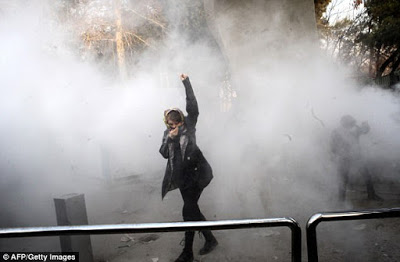A picture of defiance
 |
| TARIQ TAHIR FOR MAILONLINE and TIM STICKINGS FOR MAILONLINE 30.12.2017 |
Iranian woman protester raises her fist amid a cloud of choking tear gas in Tehran after mullahs launch violent crackdown and order counter rallies by loyalists on third day of demonstrations against hardline regime
- Students clashed with riot police at the University of Tehran on Saturday
- Riot police hit backs with riot police as the protests continue across Iran
- Hard-liners had rallied in the capital to support the Iranian government
- Protests began on Thursday against the Islamic Republic’s struggling economy
Police in Tehran hit back with tear gas at stone throwing students who took part in a third day of of nationwide protests against government.
At least 50 people have arrested since the protests began on Thursday in Mashhad, the country’s second-largest city, in what has been the most serious challenge to the Islamic Republic since demonstrations following the disputed 2009 presidential election.
There was chaos around the University of Tehran on Saturday as several hundred people scuffled with police and shouted slogans against the regime for several hours, bringing traffic to a standstill.
Pictures also show burning vehicles in the streets of Tehran as the protests continued into the night with Telecoms minister Mohammad-Javad Azari Jahromi accusing a a popular television station of encouraging the ‘use of Molotov cocktails, armed uprising, and social unrest’.
Videos shared by social media users outside Iran claimed to show thousands marching peacefully in several cities including Khorramabad, Zanjan and Ahvaz, with chants of ‘Death to the dictator’, in reference to Supreme Leader Ayatollah Ali Khamenei.
But the regime also put on a show of strength, with hundreds of counter-demonstrators seizing control of the university entrance in Tehran, chanting ‘Death to the seditionists’.
Rocks were thrown at police as anti-government students protested at the University of Tehran but were outnumbered by conservative classmates who shouted ‘death to the seditionists’ and took control of the campus entrance.
Earlier some 4,000 pro-regime demonstrators had gathered at the Musalla prayer ground in the centre of Tehran, calling for criminal trials for the leaders of the anti-government Green Movement.
Iran’s interior minister warned people against taking part in ‘unlawful gatherings’, saying they needed to apply for a permit first.
Three University of Tehran students were arrested, according to a government official.
The pro-regime demonstrations had been scheduled weeks ago but took on new significance after the protests began on Thursday, sparked by social media posts and a surge in prices for basic food supplies.
But the protests have broadened into criticism of Iran’s government, with one woman filmed waving a white flag after taking off her hijab to protest the Islamic dress code for women.
Today’s pro-government rally was meant to mark eight years since a 2009 pro-government demonstration, supporting the re-election of hard-line President Mahmoud Ahmadinejad after a disputed poll.
It came as U.S. President Donald Trump tweeted to say ‘the world is watching’ the protests and called on the government to ‘respect their people’s rights’.
Thousands have taken to the streets in Iranian cities this week, starting in Mashhad, where 52 people were arrested in the country’s second-largest city.
Footage posted on Twitter by Iranian author Armin Navabi showed a woman who had taken off her hijab waving a white flag as she stood among a crowd.
State-run media outlets have not reported widely on the protests, but state television aired live footage of the pro-government rally on Saturday, showing people waving flags and carrying banners bearing the image of Iran’s Supreme Leader Ayatollah Ali Khamenei.
The Tehran demonstrators called for criminal trials for Mir Hossein Mousavi and Mahdi Karroubi, leaders in the Green Movement who have been under house arrest since 2011.
Iranian President Hassan Rouhani, whose administration struck the 2015 nuclear deal with world powers, campaigned on freeing the men, although they currently remain held.
The spontaneous demonstrations this week appear to be the largest in the Islamic Republic since its 2009 Green Movement arose after Mr Ahmadinejad’s re-election.
Social media videos this week showed clashes between protesters and police, while the semi-official Fars news agency said protests also struck Qom, a centre of Shiite Islamic scholarship and home to a major shrine.
U.S. President Donald Trump tweeted his support for the protests, saying: ‘Many reports of peaceful protests by Iranian citizens fed up with regime’s corruption & its squandering of the nation’s wealth to fund terrorism abroad.
‘Iranian govt should respect their people’s rights, including right to express themselves. The world is watching! #IranProtests.’
The U.S. State Department also issued a statement Friday supporting the protests, saying: ‘Iran’s leaders have turned a wealthy country with a rich history and culture into an economically depleted rogue state whose chief exports are violence, bloodshed and chaos.’
Mohsen Araki, a Shiite cleric who serves in Iran’s Assembly of Experts, praised Rouhani’s efforts at improving the economy. However, he said Mr Rouhani needed to do more to challenge ‘enemy pressures.’
‘We must go back to the pre-nuclear deal situation,’ he said. ‘The enemy has not kept with its commitments.’
Ali Ahmadi, a pro-government demonstrator, blamed the U.S. for all of Iran’s economic problems.
‘They always say that we are supporting Iranian people, but who should pay the costs?’ he said.
Iran’s economy has improved since the nuclear deal, which saw Iran limit its enrichment of uranium in exchange for the lifting of sanctions which had crippled its economy.
Tehran now sells its oil on the global market and has signed deals for tens of billions of dollars of Western aircraft, but the improvement has not always reached the average Iranian.
Unemployment remains high at 12.4 per cent, and a recent increase in egg and poultry prices by as much as 40 per cent, blamed on a cull over avian flu fears, appears to have been the spark for the protests.


